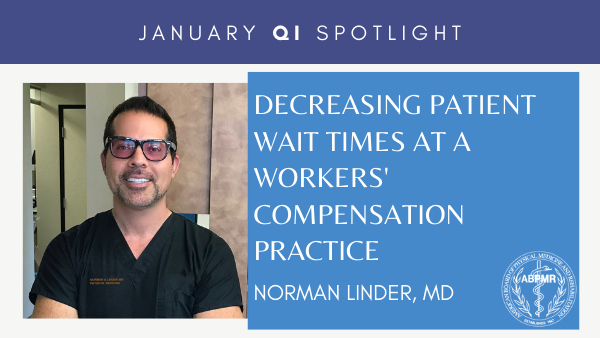CC
QI Spotlight: Decreasing Patient Wait Times at a Workers' Compensation Practice

The January QI (Quality Improvement) Spotlight was submitted by Norman Linder, MD.
Dr. Linder runs a workers' compensation practice in California and has experienced the challenges of keeping patient wait times short in his practice. Patient wait times at other practices can be up to several hours, and Dr. Linder found a major factor contributing to long wait times at his practice was the Qualified Medical Exam (QME), an evaluation required for workers' compensation patients.
Dr. Linder began his QI with the goal of decreasing the total patient wait time for a QME evaluation to below 90 minutes. At the end of four weeks, Dr. Linder and his team successfully met their goal and improved efficiency in their practice.
Thank you for submitting your QI, Dr. Linder!
The QI Spotlight (formerly the PIP Spotlight) is a periodic feature on the ABPMR News Center to highlight exemplary Quality Improvement projects submitted by your fellow diplomates (or residents) for continuing certification (CC) credit. Diplomates can use the QI Spotlight as a tool to plan their own QIs or as a way to connect with other diplomates doing similar work.

What is the problem you are trying to solve?
My patients typically wait a total of about one hour to complete their visit with my clinic (excluding the time I personally spend with them).
The longest wait times are for my performance of the Qualified Medical Exam (QME). If you're not familiar with this exam, it involves interviewing and examining the patient regarding workplace injuries and determining if the injury occurred as a result of work while at work, what degree of impairment they've suffered, what kind of work restrictions they require, appropriate periods of disability, apportioning percentage of injury(ies) to current work versus prior work and/or non-industrial injuries, and performing and ordering diagnostic testing to fully evaluate the patient. This requires coordination of reports and testing in a time-sensitive manner so that all involved parties (applicant, applicant attorney, employer, defense attorney, and insurer obtain reports within 30 days of my first contact with the patient (actually workers' comp applicant).
Applicants are supposed to provide their medical/work/activities of daily living prior to arriving on the examination date. For various reasons, this is sometimes not done. Applicants also need to have vitals and measurements taken (BP, pulse, RR, height, weight, temperature, Jamar hand grip, arm and leg girth measurements, and spine ROM measurements) before I see them.
When I meet each applicant, I explain the nature of the QME evaluation and why it was requested. California regulations require I spend at least 20 minutes with each applicant face to face (more time is usually required to go over the history) and to thoroughly perform physical exams on the involved body parts. Often times, I will need to perform EMG and NCV testing to rule out radiculopathy, plexopathy, and/or peripheral nerve entrapment on the same day.
What data (objective measurements) do you have that supports this as a problem?
Patients are averaging a 30-minute wait time before they first see me. However, during that time they are getting their vitals and having measurements done by my medical assistants.
What is your opportunity statement? State the goal you hope to achieve.
My goal is to have the patient's total time spent in our office for a QME evaluation to be less than 90 minutes, which is quite reasonable when compared to the total amount of time a patient typically spends in other workers' comp offices. This goal encompasses my thorough interview and physical exam and any in-house EMG/NCV I would need to perform on the patient.
What is the underlying cause of the performance/quality problem?
There are many causes to increased waiting time in workers comp offices where the QME is often performed:
- No printed or digitally available history for the patient. Thus, I have to start from scratch rather than review the history with the patient.
- The DEU100 (patient demographics, activities of daily living inventory) has not yet been filled out prior to the appointment. This form takes lots of time to fill out.
- No medical records yet available for review. I then have to rely on the patient if and/or when he/she last had diagnostic testing (i.e. MRI, NCV/EMG, Ultrasound, etc.) done.
- No attorney referral letter available at the time of the patient appointment. I cannot start the history or interview with the patient because I do not know which body parts are included with the workers' comp claim.
- Mandatory state-certified interpreter did not show up or shows up late for the appointment for patients who require language interpretation.
- Medical assistant isn't available and, thus, I need to perform obligatory tasks such as patient sign-in, vital signs, Jamar hand grip, leg and arm girth measurements, and spine ROM that take away from the important time I need to spend with the patient, such as reviewing their histories and performing a comprehensive physiatric physical exam.
- Backup physician to perform in-office EMG/NCV on the day of my QME evaluation with the patient is not available.

What change(s) did you implement?
- I have between 30 and 60 days for the historian to take the patient's history. Possibly, a single historian is too overworked and does not have enough time to interview my patients, even with up to 60 days. Therefore, I need to have more capable numbers of historians available. Sometimes, the patient has no phone numbers or an incorrect phone number. I need to have back office verify the correct and best phone number(s) to reach each patient at the time the appointment is made. The appointment is made between 30 and 60 days in advance of the day the patient will see me. The patient histories should always be available digitally and at least one week in advance of the appointment date.
- It's important that the patient has access to and fills out the DEU100 (demographics and activities of daily living inventory) at least one week in advance of the appointment. The form should be mailed to the patient or have the attorney's office provide it to him/her.
- Obtaining medical records (even within 60 days) is often a difficult task. Thus, medical records and their summaries may not always be available at the time of the appointment. That's okay, as I can issue a supplemental report after I've received the medical records. I'd have my medical assistant verify with each patient at the time of their appointment with me what kind of diagnostic tests they've had and when they were last done.
- Attorney letters are absolutely essential to determine what body parts of each patient I am to evaluate. My back office staff needs to phone and fax requests for attorney letters with the goal to have these letters available in our system no later than one week prior to the appointment time.
- Office staff need to verify with the insurance company, who pays for the mandatory state-certified interpreter, that each patient who requires an interpreter will have one at appointment time. This needs to be completed no less than one week in advance of the patient's appointment.
- I need redundancy or back-up medical assistants to be available because my regular medical assistant may not be available due to illness, personal issues, or other issues out of his/her control (i.e. traffic and traffic accidents).
- I need to have redundancy and other physicians to perform in-office EMG/NCV on the day of my QME evaluation with the patient.

Did you achieve your goal or target from your opportunity statement? What data do you have to support your conclusion?
My practice met its goal of reducing the total time spent in my office to under 90 minutes for QME evaluations after four weeks. Total patient time in my office approximated 120 minutes, but now with some of the strategies implemented, my patients spend about 70-80 minutes on average in my office.

Will you continue with the changes you have implemented?
I achieved my goals and will continue with improving each of the strategies I implemented.



